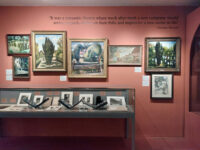
A Garden of One’s Own

LONDON — Lady Ottoline Morrell, Vanessa Bell, Virginia Woolf, and Vita Sackville-West: female cornerstones of the Bloomsbury group whose creative output spanned novels, poetry, painting, sewing, photography — and gardening. Gardening Bohemia: Bloomsbury Women Outdoors at the Garden Museum aims to explore how each woman’s garden became a site of refuge as well as a space for creative experimentation. These women upended the established parameters of fiction, domestic life, and feminist thought, so this is an exciting premise. However, as the exhibition unfurls, the idea of garden as sanctuary supplants the idea of it as site of experimentation. This feels like a missed opportunity to consider whether the gardening of Bloomsbury women might have been as radical as their fiction, painting, and redefining of gender roles.
In the section dedicated to Woolf’s garden at Monk’s House in East Sussex, for instance, we learn about how it “offered privacy, tranquility, and a therapeutic connection with nature,” as the wall text puts it, via a collection of photographs of her in it. However, it would have been interesting to explore how the garden might have inspired her experimental writings. Woolf’s novels and diaries are full of a truly radical sense of the continuities between plant and human lives; her explorations of nonhuman perspectives still feel fresh a century later. In her short story “Kew Gardens” (1919), for example, Woolf creates a compelling series of snapshot narratives from the perspective of a snail overhearing the words of passersby, weaving together human and nonhuman concerns in a verbal tapestry. Yet, in this exhibition, we are offered only a tantalizing hint at the end of the wall text of how Woolf and her lover Sackville-West enjoyed the garden together — one that, in Woolf’s words, was “full of lust and bees, mingling in the asparagus beds.” This is a brilliant evocation of queer sexuality that could also be seen as a mode of ecological “mingling” across species, nurtured in the context of the garden.


The section on Lady Ottoline Morrell’s garden at Garsington, on the other hand, successfully frames the space as a site for alternative modes of living and thinking. According to the wall text, Morrell saw her garden as a “theatre,” where she gathered some of the most exciting artists and writers of the early 20th century. It was a place of freedom, in which sexual mores could be discussed and thrown off, as suggested by a pair of 1917 photographs by Morrell of painter Dora Carrington posing naked on a statue. At the same time, the exhibition explains, Morrell was also using Garsington to offer refuge to conscientious objectors who refused to fight during World War I, such as the artist Mark Gertler, whose paintings of Garsington are on view. Morrell gave him and his fellow pacificists work as agricultural laborers to excuse them from conscription or prison.
As well as being a hostess, photographer, and gardener, Morrell also made clothes and embroideries inspired by her garden. Unfortunately, the lighting is too dark to see these clearly (perhaps for reasons related to conservation). Similarly, the space feels cramped and oppressive in places, sitting awkwardly between an art exhibition and an informational or archival display. Fittingly, the exhibition comes to life outdoors, where the museum has worked with gardeners from each of the Bloomsbury gardens to curate planters filled with flowers. Joyful and unrestrained, the plants wave in the breeze and nod with visiting pollinators, suggesting the freedom that these four extraordinary women sought in their lives and gardens.


Gardening Bohemia: Bloomsbury Women Outdoors continues at the Garden Museum (5 Lambeth Palace Road, London), through September 29. The exhibition was organized by Claudia Tobin.



